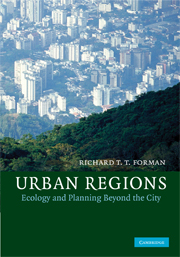Book contents
- Frontmatter
- Contents
- Foreword
- Foreword
- Preface
- Acknowledgments
- 1 Regions and land mosaics
- 2 Planning land
- 3 Economic dimensions and socio-cultural patterns
- 4 Natural systems and greenspaces
- 5 Thirty-eight urban regions
- 6 Nature, food, and water
- 7 Built systems, built areas, and whole regions
- 8 Urbanization models and the regions
- 9 Basic principles for molding land mosaics
- 10 The Barcelona Region's land mosaic
- 11 Gathering the pieces
- 12 Big pictures
- Appendices
- References
- Index
- Plate section
2 - Planning land
Published online by Cambridge University Press: 04 August 2010
- Frontmatter
- Contents
- Foreword
- Foreword
- Preface
- Acknowledgments
- 1 Regions and land mosaics
- 2 Planning land
- 3 Economic dimensions and socio-cultural patterns
- 4 Natural systems and greenspaces
- 5 Thirty-eight urban regions
- 6 Nature, food, and water
- 7 Built systems, built areas, and whole regions
- 8 Urbanization models and the regions
- 9 Basic principles for molding land mosaics
- 10 The Barcelona Region's land mosaic
- 11 Gathering the pieces
- 12 Big pictures
- Appendices
- References
- Index
- Plate section
Summary
How much of the land should be planned and how much designed? I would say that remote areas dominated by natural processes should only be subjected to the broadest-scale planning, and certainly should escape any fine-scale design. The rest of the world needs broad-scale planning to identify, protect, and develop best land uses. In contrast, fine-scale design that protects and creates inspiring places for people is extremely valuable in scattered spots, especially in urban regions where people concentrate. How would you answer the question?
Land planning is now considered from three broad perspectives: (1) planning and land management; (2) conservation planning; and (3) urban planning focused on urban regions.
Planning and land management
Leading off the chapter with land management highlights the relatively short-term issues of planning, where adaptively managing existing land and its resources, particularly protected land, is the goal. We begin with some perspectives on the role of planning, and then focus on land management.
The role of planning
Physical planning is the prime concern here, rather than the relatively non-spatial political, economic, social, and policy planning. Both urban planning and conservation planning focus on space. Place is more important in urban planning, and habitat in conservation planning. Both place and habitat have deep ties and meaning to space. Place includes the natural and the built, but expresses the human affinity for a space (Norberg-Schulz 1980, Seddon 1997).
- Type
- Chapter
- Information
- Urban RegionsEcology and Planning Beyond the City, pp. 27 - 50Publisher: Cambridge University PressPrint publication year: 2008



